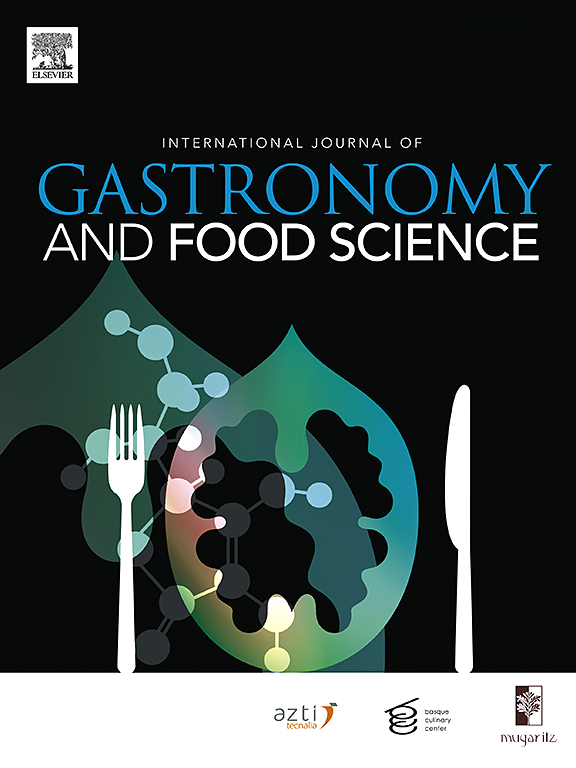非物质文化遗产的出口:国际媒体如何描绘瑞典fika ?
IF 3.2
2区 农林科学
Q2 FOOD SCIENCE & TECHNOLOGY
International Journal of Gastronomy and Food Science
Pub Date : 2024-12-30
DOI:10.1016/j.ijgfs.2024.101096
引用次数: 0
摘要
本文探讨了非物质文化遗产如何被“输出”到不熟悉其潜在价值的环境中。非物质文化遗产是指社区认为与其传统和背景不可或缺的表达方式、实践、知识和技能。虽然这些方面对于文化内部的人来说是熟悉的,但在将它们转移到外部并使其理解时,就会出现挑战。本文以瑞典fika的“出口”为背景,对这一现象进行了研究。通过在国外建立名为“Fika”的咖啡机,出口相关产品,以及将Fika作为未经翻译的名词和动词纳入英语,这种全球出口是显而易见的。经验证据是从瑞典fika是如何在国际媒体描绘的检查得出的。Fika可以从烹饪、社会、空间、时间和象征的维度来理解。通过关注盎格鲁-撒克逊新闻和广播媒体的报道,论文提出:瑞典fika的哪些方面被描述,它们如何在国际媒体中呈现?本文的结论是,瑞典的fika主要以三种方式构成:(1)作为有形的(消费的饮料和糕点);(2)作为仪式;(3)作为一种悖论,fika的影响被强调为一种矛盾的或令人惊讶的结果。这些框架与特定的fika环境有关,仪式和有形的东西与咖啡厅的环境密切相关,而悖论与工作场所的环境有关。本文通过展示如何将非物质文化元素定型或具体化,为现有研究做出贡献,突出了在非物质文化遗产出口中保持真实性的持续挑战。本文章由计算机程序翻译,如有差异,请以英文原文为准。
Intangible cultural heritage on export: How is Swedish fika portrayed in international press?
The paper explores how intangible cultural heritage is “exported” to contexts unfamiliar with its underlying values. Intangible cultural heritage refers to the expressions, practices, knowledge, and skills that communities recognise as integral to their traditions and background. While these aspects are familiar to those within the culture, challenges arise when transferring and making them understandable to outsiders. The paper studies this phenomenon in the context of the “export” of Swedish fika. Such global exports are evident through the establishment of cafés named "Fika" abroad, the export of related products, and the incorporation of the term fika as an untranslated noun and verb into the English language. Empirical evidence is drawn from an examination of how Swedish fika is portrayed in international media. Fika can be understood along culinary, social, spatial, temporal, and symbolism dimensions. By focusing on coverage in the Anglo-Saxon press and broadcast media, the paper asks: Which dimensions of Swedish fika are described, and how are they presented in international media? The paper concludes that Swedish fika is framed in three primary ways: (1) as tangibles (the beverages and pastries consumed); (2) as a ritual; and (3) as a paradox whereby the effects of fika are emphasised as a contradictory or surprising consequence. These frames are tied to specific fika settings, with the ritual and tangibles being closely associated with cafés, while the paradox is linked to workplace contexts. The paper contributes to existing research by showing how intangible cultural elements can be stereotyped or made tangible, highlighting the ongoing challenges of maintaining authenticity in the export of intangible cultural heritage.
求助全文
通过发布文献求助,成功后即可免费获取论文全文。
去求助
来源期刊

International Journal of Gastronomy and Food Science
Social Sciences-Cultural Studies
CiteScore
5.30
自引率
10.50%
发文量
170
审稿时长
45 days
期刊介绍:
International Journal of Gastronomy and Food Science is a peer-reviewed journal that explicitly focuses on the interface of food science and gastronomy. Articles focusing only on food science will not be considered. This journal equally encourages both scientists and chefs to publish original scientific papers, review articles and original culinary works. We seek articles with clear evidence of this interaction. From a scientific perspective, this publication aims to become the home for research from the whole community of food science and gastronomy.
IJGFS explores all aspects related to the growing field of the interaction of gastronomy and food science, in areas such as food chemistry, food technology and culinary techniques, food microbiology, genetics, sensory science, neuroscience, psychology, culinary concepts, culinary trends, and gastronomic experience (all the elements that contribute to the appreciation and enjoyment of the meal. Also relevant is research on science-based educational programs in gastronomy, anthropology, gastronomic history and food sociology. All these areas of knowledge are crucial to gastronomy, as they contribute to a better understanding of this broad term and its practical implications for science and society.
 求助内容:
求助内容: 应助结果提醒方式:
应助结果提醒方式:


